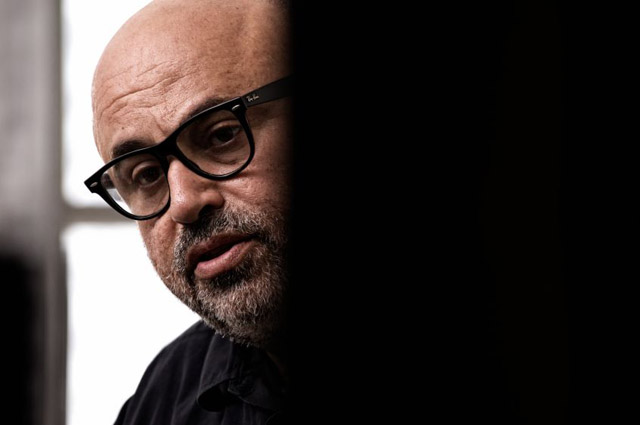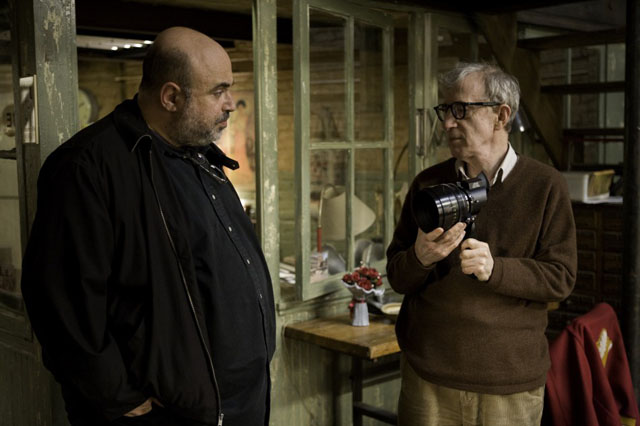Alarming news from cinematographer Adam Frisch, posted in the forums at Cinematography.com this morning: “It’s my very sad duty to report that Harris Savides has just died. Harris had been sick for awhile, but was as far as I know doing better. Don’t know the final cause of death. Not only a brilliant DP and a true legend in his own time, but also by all accounts from people that knew him—a true gent.” And he adds a link to a video (4’43”) in which Savides, rummaging through the shelves in Criterion’s storage room, talks about some of the films and filmmakers that meant the most to him.
On Facebook, the Film Stage notes that Savides’s “last film, The Bling Ring, will be released next year.” The director is Sofia Coppola, with whom Savides worked on Somewhere (2010).
Introducing an interview with Savides in 2010, the Museum of the Moving Image’s David Schwartz called him “a bearish man who is soft-spoken and modest, and is among the world’s premiere cinematographers”:
A devoted cinephile, Savides is the direct heir to 1970s auteur cinema: both the New Hollywood of Rafelson, Pakula, and Altman, and the European cinema of Rohmer, Bergman, and Tarkovsky….
Savides’s success as a director of photography on music videos and commercials has afforded him the luxury of only working with directors he wants to work with. So far, that includes James Gray, Gus Van Sant, Noah Baumbach, David Fincher, and Sofia Coppola… It may be a coincidence, but some of his finest work has been for movies set in the 1970s, including Milk, Zodiac, and American Gangster….
Savides’s artistry is a bit hard to define; he doesn’t have a trademark device (although he is remarkably adept at fluid long takes)…. Serving the rhythms and personalities of the performers, he is an actor’s best friend. He is also a filmgoer’s best friend: he creates compositions that breathe, that give us the time and the space to see the world in a new light.
Updates: In a comment below, Alex points us of another video interview (6’41”), conducted by CINE-FILS, where Felix von Boehm writes, “More than anything else, it is through [the] floating traveling shots made by the cinematographer Harris Savides that we remember the three films that are referred to as Gus Van Sant’s ‘Death Trilogy’.” And he takes a closer look at Gerry (2002), Elephant (2003), and Last Days (2005).
“We’ve genuinely lost a unique look at the world, and thus a very special vision of cinema,” writes MUBI’s Notebook above a clip from Gerry.
The Playlist has “picked out some of our favorite pieces of his work (although it should be said that Savides never shot a frame of film that didn’t look glorious).” Most appreciations are accompanied by clips, too.
Glenn Kenny posts three amazing stills.
“He and [Mark] Romanek collaborated on several memorable videos, including R.E.M.’s ‘Everybody Hurts,’ Madonna’s ‘Rain’ and ‘Bedtime Story,’ Michael Jackson’s ‘Scream,’ and Nine Inch Nails’ ‘Closer,'” notes Phil Dyess-Nugent at the AV Club, where he, too, has clips. “‘A lot of times,’ he once told Interview, ‘directors tell me what they want, and I’ll try to figure it out. I don’t ever want to come to the table with my preconceived notions.’ He summed up his personal philosophy of cinematography by saying, ‘You shouldn’t see the photography in the film.'”
Updates, 10/12: “The cause was brain cancer, said his wife, Medine.” Bruce Weber in the New York Times: “‘He made the films totally what they should have been,’ [Noah] Baumbach said in an interview Thursday. ‘We would sit together and I’d talk about how I imagined the movie looking and feeling In [Margot at the Wedding], I said I wanted a feeling of being indoors in a house with a lot of windows when you’ve been inside for a while and the sun has gone down and you realize you’re sitting in a dark room. It wasn’t necessarily a scene in the movie, just a feeling for the movie. And he’d go off and do tests, and when I looked at the tests, it was as though the feeling had been translated into pictures.'”
At Slate, Aisha Harris and Forrest Wickman post a clip: “While watching the horrific scene from Zodiac below, for instance, most viewers might not pause to note how gorgeously Savides has captured the golden sunlight and the shadows cast by small trees. But the idyllic scene that Savides helped to paint contrasts stunningly with the killer cloaked in black, visually conveying the story Fincher wanted to tell about grisly murders that haunted the Bay Area in the 1970s.” They also post that remarkable closeup of Nicole Kidman in Jonathan Glazer’s outstanding Birth, another from Elephant, and the opening scene from Gerry.
More frames from David Liu.
Updates, 10/13: At Press Play, Nelson Carvajal posts a video tribute, and Matt Zoller Seitz writes an appreciation and discusses Savides’s work with Jamie Stuart. Matt: “His mix of artistic restlessness and quiet confidence bridged schools of filmmaking that might seem incompatible: virtuosity and naturalism. He came out of the world of fashion and TV ads and music videos, but when you look at his feature work, you rarely get the sense that you’re being sold anything. There’s a reticence and mystery to his images, as audacious as they often are.” Jamie: “He inspired me in the sense that I always sent him my work—and considering how highly I thought of him, I damn well hoped my work would be good enough to show him. He was somebody, a professional, who was there for me as I was embarking on my filmmaking career. And that’s something I’m grateful for.”
“In what is easily the most informative internet message board thread I’ve ever come across, ‘birth – Harris Savides,’ which was started on Cinematography.com by a young man you may have heard of named Jody Lipes on November 1, 2004, the conversation turns around midway through to the aggressive underexposure used by Savides on Birth,” which Zachary Wigon, writing at Filmmaker, argues “is Savides’s greatest work. The creaminess of the film, of the texture, which persists despite a definite grain, is a great counterintuitive feat of cinematography.”
“While directors frequently turned to him for a visual style redolent of 1970s American and European auteur cinema, Savides was at the forefront of digital experimentation,” notes Ryan Gilbey in the Guardian. “He shot Fincher’s Zodiac (2007), the fastidiously detailed story of the real-life hunt for a serial killer in San Francisco in the 1960s, entirely on the HD Viper camera. going to great lengths to give the movie an authentic period texture.”
Henry Stewart presents five clips at the L.
Update, 10/14: Sight & Sound editor Nick James: “The complex choreography of the chilling Steadicam takes at the school in Elephant is one thing, the mesmerizing profile shots of the boys tramping through the desert in Gerry is another, the skin-pricking eeriness of the faces and apartments in the under-rated Birth yet another; but what makes almost every Savides shot so eloquent is that he always allows the quality of the locale, space or scene to play itself and not be subdued.” And further down that same page, DP Seamus Mcgarvey: “Harris Savides was the most gifted cinematographer of his generation.”
Update, 10/16: A collection of stills at ffffilm; and a remembrance (in French) from Olivier Père.
Update, 10/21: “There’s an earthy sensuality to Savides’s pictures that sets him apart from his forebears,” writes Carson Lund in MUBI’s Notebook. “To a certain extent, Savides developed a particular look for each of the filmmakers he regularly collaborated with: muted colors, minimalist compositions, and Tarr-esque longueurs in relatively boxy ratios for Gus Van Sant; milky tones and crisp lines in widescreen for David Fincher; understated pastels and unshowy framings for Noah Baumbach. For his one-time collaborations—James Gray, Jonathon Glazer, Ridley Scott, Woody Allen, and Sofia Coppola all received this privilege—he served up subtle variations on those primary approaches. To his colleagues, he was a DP renowned for his ability with soft light, using an array of bounce boards and diffusion to achieve an invisibility of effect, and this reputation was perhaps what led him to these directors, all of whom (with the slight exception of Scott) share a propensity for, for lack of a better term, pictorial naturalism, for keeping lights where they would logically be placed and cameras where they could feasibly be manned by a human being.”
For news and tips throughout the day every day, follow @KeyframeDaily on Twitter and/or the RSS feed. Get Keyframe Daily in your inbox by signing in at fandor.com/daily.





